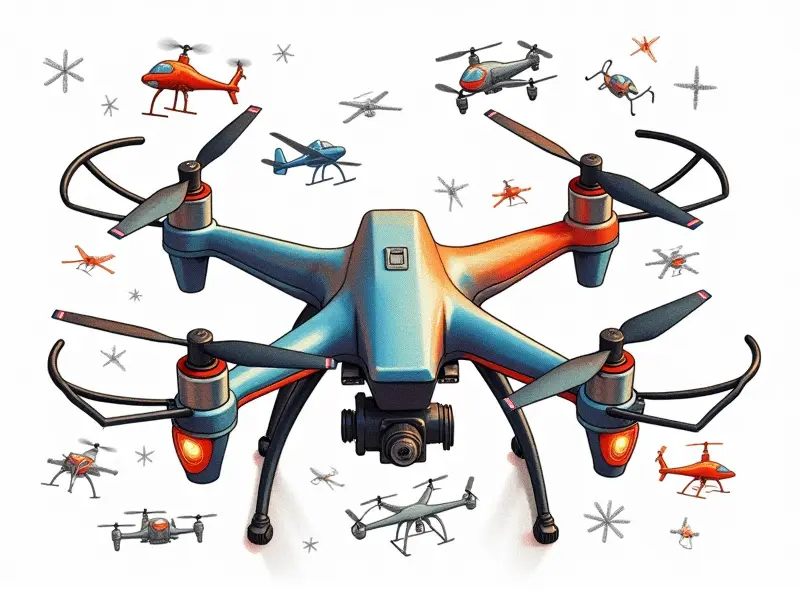Why is my drone's range limited?

Understanding Factors That Limit Drone Range
The range of your drone can be affected by a variety of factors, including signal interference, antenna quality, and environmental conditions. Signal interference from other devices or terrain features like hills and buildings can significantly reduce the effective range of your drone's communication system.
Maximizing FPV Racing Drone Signal Range
FPV racing drones rely heavily on low-latency video transmission to provide a smooth, immersive flying experience. To maximize signal range for these high-speed racers, consider upgrading your antenna to a directional model designed specifically for long-distance communication.
Selecting the Right Antenna
- High-Gain Antennas: Use high-gain antennas that provide better directionality and signal strength over distance.
- Dual-Antenna Systems: Implement dual-antenna setups for redundancy and improved reliability, especially in crowded frequency environments.
Tips to Increase Drone Transmission Range
Increasing the transmission range of your drone involves both hardware upgrades and optimizing settings. Here are some effective strategies:
Upgrade Your Radio Module
- FCC Certified Modules: Opt for radio modules certified by the FCC to ensure compliance with regulatory standards.
- Better Power Output: Choose modules that offer higher power output, which can significantly extend your drone's range.
Optimize Flight Parameters
- Reduce Video Quality: Lowering the video quality setting on your FPV goggles or monitor can help reduce latency and increase transmission distance.
- Increase Data Rate: Increasing the data rate of your telemetry link can improve signal strength but may also introduce more noise, so balance is key.
Troubleshooting Limited RC Helicopter Flying Distance Issues
RC helicopters often face unique challenges when it comes to range. Here are some common issues and their solutions:
Interference from Other Devices
- Change Frequency Channels: Switch your helicopter's frequency channel if you're experiencing interference.
- Use 2.4GHz or 5.8GHz Bands: These bands offer less interference and better range for RC devices.
Antenna Placement & Quality
- Proper Antenna Positioning: Ensure that your antenna is correctly positioned on the helicopter to maximize signal strength.
- High-Quality Components: Invest in high-quality antennas and connectors to minimize signal loss.
How to Improve Your Drone's Flight Distance
To enhance your drone's overall flight distance, focus on both hardware modifications and operational practices:
Hardware Enhancements
- Battery Capacity: Increase the capacity of your drone’s battery pack.
- Lights & Beacons: Add lights or beacons to improve visibility in low-light conditions, which can extend operational time.
Flying Techniques
- Avoid Obstructions: Plan your flight paths around obstacles that could cause signal degradation.
- Optimal Flying Altitude: Fly at an optimal altitude to avoid interference from buildings and other obstructions.
Common Reasons for Short Drone Operating Range
A variety of factors can contribute to a short operating range, including:
Signal Interference
- Electromagnetic Noise: Electromagnetic noise from other electronic devices or wireless networks.
- Distance from Controller: The farther your drone is from the controller, the weaker the signal becomes.
Environmental Conditions
- Weather Impact: Rain and fog can absorb or scatter radio signals, reducing range.
- Terrain Obstacles: Hills, trees, and buildings can block the signal path between drone and controller.
Enhance RC Quadcopter Signal Strength & Range
To boost your quadcopter's performance in terms of range, consider these tips:
Optimize Frequency Band Usage
- Select Clear Channels: Choose frequency channels that have minimal interference.
- Use Dedicated Frequencies: Reserve specific frequencies for your quadcopter to avoid overlap with other devices.
Battery Management
- High-Capacity Batteries: Use high-capacity batteries that can power your drone longer, increasing its operational range.
- Battery Placement: Properly position the battery to ensure optimal weight distribution and stability during flight.
Maximizing Drone Range: Tips for FPV Racing Pilots
To maximize your range as an FPV racing pilot, follow these specialized tips:
Use Directional Antennas
- Omni-Directional vs. Yagi-Uda: Opt for directional antennas like the Yagi-Uda to focus signal strength in a specific direction.
- Antenna Alignment: Ensure your drone's antenna is aligned with the pilot’s receiver for optimal range and performance.
Increase Transmission Power
- Power Output Settings: Adjust power output settings on both transmitter and receiver to maximize signal strength.
- Transmitter Upgrades: Upgrade your transmitter with a more powerful unit if needed, but ensure compliance with regulations.
Extend Your Drone's Reach: Quick Fixes & Upgrades
If you're looking for immediate improvements to your drone’s range, these quick fixes and upgrades can make a significant difference:
Software Adjustments
- Firmware Updates: Keep your drone's firmware up-to-date with the latest bug fixes and performance enhancements.
- Channel Hopping: Implement channel hopping technology to dynamically switch frequencies, avoiding interference.
Hardware Upgrades
- Better Quality Components: Replace lower-quality components with higher-grade equivalents for improved performance.
- Signal Booster Modules: Install signal booster modules to amplify your drone’s transmission power.
Breaking Down Barriers To Long-Range Drone Flying
To break down barriers and achieve long-range flying, consider the following comprehensive strategies:
Regulatory Compliance
- Airspace Regulations: Understand airspace regulations to ensure compliance while maximizing range.
- Licensing Requirements: Obtain necessary licenses for extended flight ranges as required by aviation authorities.
Technological Innovations
- Advanced Antennas: Explore the latest antenna technologies designed specifically for long-range drone operations.
- Battery Technologies: Utilize cutting-edge battery solutions that offer higher capacity and longer operational times.
Conclusion
By addressing signal interference, optimizing frequency usage, enhancing hardware components, and adopting best practices for flying techniques, you can significantly improve your drone’s range. Remember to stay informed about regulatory requirements and technological advancements in the field of unmanned aerial systems (UAS) to continue pushing the boundaries of long-range drone operations.

